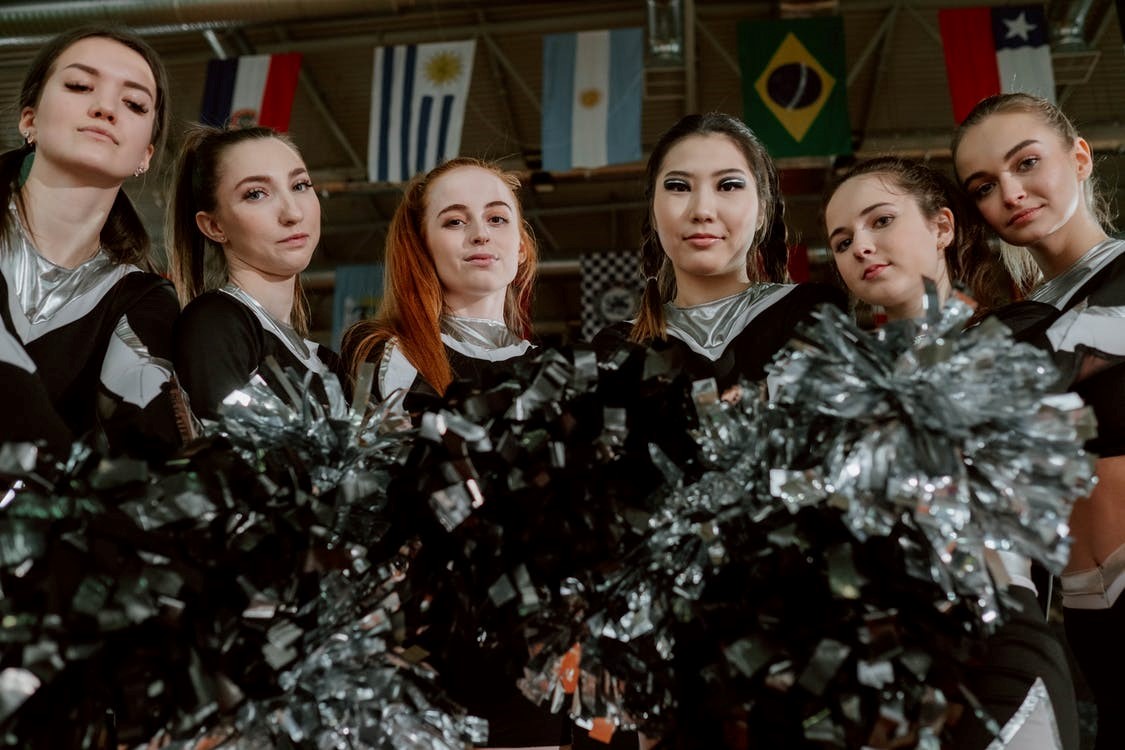
Femcompetitor.com, grapplingstars.com, fciwomenswrestling.com, fcielitecompetitor.com, fciwomenswrestling2.com Cottonbro-pexels.com-photo-credit
December 4, 2021,
It is the most dangerous activity for women in sports.
But it is not a sport. Or maybe it is.
Depending upon who you ask.
Given the amount of training and especially due to the injury factor, shouldn’t cheerleading be considered a sport?
As reported by the team at grapplingstars.com, based upon online research, “Cheerleading carries the highest rate of catastrophic injuries to girl athletes in sports.
Of the United States’ 2.9 million female high school athletes, only 3% are cheerleaders, yet cheerleading accounts for nearly 65% of all catastrophic injuries in girls’ high school athletics.
In data covering the 1982-83 academic year through the 2018-19 academic year in the US, the rate of serious, direct traumatic injury per 100,000 participants was 1.68 for female cheerleaders at the high school level, the highest for all high school sports surveyed.
Another study found that between 1982 and 2007, there were 103 fatal, disabling, or serious injuries recorded among female high school athletes, with the vast majority (67) occurring in cheerleading.
The main source of injuries comes from stunting, also known as pyramids.
These stunts are performed at games and pep rallies, as well as competitions. Sometimes competition routines are focused solely around the use of difficult and risky stunts. These stunts usually include a flyer (the person on top), along with one or two bases (the people on the bottom), and one or two spotters in the front and back on the bottom.
The most common cheerleading related injury is a concussion. 96% of those concussions are stunt related. Others injuries are: sprained ankles, sprained wrists, back injuries, head injuries (sometimes concussions), broken arms, elbow injuries, knee injuries, broken noses, and broken collarbones. Sometimes, however, injuries can be as serious as whiplash, broken necks, broken vertebrae, and death.”
That is saying a lot.
The effort is there. The popularity is sky high. There is intense competition for spots on college teams.

Here is how the NCAA views cheerleading. “NCAA collegiate cheerleading squads and dance teams often participate in activities that are separate from the institution’s sports program, in addition to their sports program activities. Catastrophic Medical coverage provided through the NCAA and Varsity Spirit, including UCA, NCA, USA, UDA, and NDA (Varsity), applies to many, but not necessarily all, of these activities.”
The phrasing indicates cheerleading is not part of the University’s sports program.
One way that cheer can break through that barrier is to be considered an emerging sport.
An emerging sport is a women’s sport recognized by the NCAA that is intended to help schools provide more athletic scholarships and opportunities for women and more sport-sponsorship options for the institutions, and help that sport achieve NCAA championship status.
There is progress in that regard.
On August 10, 2021, as reported by usacheer.org, “USA Cheer shares today that the NCAA Division II and III Councils will sponsor legislation to add STUNT as an emerging sport for women in their respective divisions. The legislation will be up for a member vote at the January 2022 NCAA convention. The Division I Council is expected to consider similar legislation at their meeting in October 2021.”
We are certainly hoping for the best.
Let’s look at both sides of the argument.
An important news source, dailyrepublic.com weighs in. The writer Brea Darnell states, “Cheerleaders would argue that it is, in fact, a sport. However, I disagree. Though cheerleaders endure after-school practices and even participate in cheering for their team, one must carefully evaluate the definition of a sport.”
Okay, fair enough.
What is the definition of a sport?
Here is the basic definition.
Sport is an activity involving physical exertion and skill in which an individual or team competes against another or others for entertainment.
Well said.
So by that definition, when you are watching those talented cheerleaders entertain you at football and basketball games, we have a question for you.
Who are they competing against?
Answer? No one. They are entertaining you. What other group there, is trying to “out entertain them” and win the contest?
No one.
Now for the other side of the aisle.
The writer Emily Hayden, a contributor for the news source, bfamercury.org explains, “With this definition, cheerleading fits all the criteria and therefore should be considered a sport.”
She is making that assertion based upon the same definition we just presented to you.
So what gives? What is she seeing that we are not, at least by that definition?
She continues, “Now, with all the difficult skills needed, the different competitions taking place during the season, and all the training that cheerleaders go through, it is 100% a sport.”
Emily does have a point there.
Here are a few of the organizations that judge cheer teams for awards.
At a competition.

Cheerleading Asia International Open Championships (CAIOC): Hosted by the Foundation of Japan Cheerleading Association (FJCA) in accordance with the rules and regulations of the IFC. The CAIOC has been a yearly event since 2007. Every year, many teams from all over Asia converge in Tokyo to compete.
Cheerleading World Championships (CWC): Organized by the IFC. The IFC is a non-profit organization founded in 1998 and based in Tokyo, Japan. The CWC has been held every two years since 2001, and to date, the competition has been held in Japan, the United Kingdom, Finland, Germany, and Hong Kong. The 6th CWC was held at the Hong Kong Coliseum on November 26–27, 2011.
ICU World Championships: The International Cheer Union currently encompasses 105 National Federations from countries across the globe. Every year, the ICU host the World Cheerleading Championship. This competition uses a more collegiate style performance and rulebook. Countries assemble and send only one team to represent them.
There are others. We could go on. Make no mistake about it, if your team enters the fray, you are competing against others.
From our view point, it is a sport because look at what level you have to perform at, to qualify to be a cheerleader, at the collegiate or professional level?
To make the team, you will have to compete against others.
The stakes for young cheerleaders and their parents at the high school level are very high.
They are often competing for scholarships, just like the football players.
It is a matter of time, but given the fact that the NCAA may consider them as an emerging sport, and they are competing against other sports for that status, we sense public opinion is on the cheerleader’s side.
That gives most of us something to cheer about.

~ ~ ~
OPENING PHOTO Femcompetitor.com, grapplingstars.com, fciwomenswrestling.com, fcielitecompetitor.com, fciwomenswrestling2.com Cottonbro-pexels.com-photo-credit
https://en.wikipedia.org/wiki/Cheerleading
https://wtbjc.com/blog-post-base/is-cheerleading-the-most-dangerous-high-school-and-collegiate-sport
https://www.usacheer.org/stunt-advances-to-the-final-stage-for-ncaa-emerging-sports-for-women-status
https://bfamercury.org/4178/opinion/cheerleading-is-a-sport/
https://www.fcielitecompetitor.com/
https://fciwomenswrestling.com/



